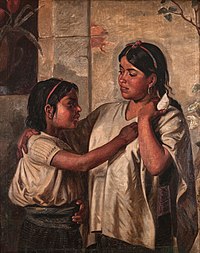
Back الشعوب الأصلية في المكسيك Arabic Pobles indígenes de Mèxic Catalan Pueblos indígenas de México Spanish بومیان مکزیک Persian Indigènes du Mexique French Urfolk i Mexico NB Povos indígenas do México Portuguese Коренные народы Мексики Russian Meksika'nın yerli halkları Turkish Người bản địa México Vietnamese
 Indigenous population by municipality in Mexico according to the CDI. | |
| Total population | |
|---|---|
Based on identification
Based on language | |
| Regions with significant populations | |
| Yucatán, Oaxaca, Chiapas, Quintana Roo, Campeche, Veracruz, Guerrero, Hidalgo, Puebla, Michoacán | |
| Languages | |
| Nahuatl, Yucatec Maya, Tzotzil, Mixtec, Zapotec, Otomi, Huichol, Totonac and another 54 living languages along the Mexican territory, as well as Spanish | |
| Religion | |
| Christianity (predominantly Roman Catholic, with Amerindian religious elements, including Mesoamerican religion) | |
| Related ethnic groups | |
| Indigenous peoples of the Americas Mestizos in Mexico |

Indigenous peoples of Mexico (Spanish: gente indígena de México, pueblos indígenas de México), Native Mexicans (Spanish: nativos mexicanos) or Mexican Native Americans (Spanish: pueblos originarios de México, lit. 'Original Peoples of Mexico'), are those who are part of communities that trace their roots back to populations and communities that existed in what is now Mexico before the arrival of Europeans.
The number of indigenous Mexicans is defined through the second article of the Mexican Constitution. The Mexican census does not classify individuals by race, using the cultural-ethnicity of indigenous communities that preserve their indigenous languages, traditions, beliefs, and cultures.[7] As a result, the count of indigenous peoples in Mexico does not include those of mixed indigenous and European heritage who have not preserved their indigenous cultural practices. Genetic studies have found that most Mexicans are of partial indigenous heritage.[8] According to the National Indigenous Institute (INI) and the National Institute of Indigenous Peoples (CDI), in 2012 the indigenous population was approximately 15 million people, divided into 68 ethnic groups.[9] The 2020 Censo General de Población y Vivienda reported 11,132,562 people living in households where someone speaks an indigenous language, and 23,232,391 people who were identified as Indigenous based on self-identification.[1][10]
The indigenous population is distributed throughout the territory of Mexico but is especially concentrated in the Sierra Madre del Sur, the Yucatán Peninsula, the Sierra Madre Oriental, the Sierra Madre Occidental, and neighboring areas. The states with the largest indigenous population are Oaxaca and Yucatán, both having indigenous majorities, with the former having the highest percentage of indigenous population. Since the Spanish colonization, the North and Bajio regions of Mexico have had lower percentages of Indigenous peoples, but some notable groups include the Rarámuri, the Tepehuán, the Yaquis, and the Yoreme.[11]
- ^ a b c "Principales resultados del Censo de Población y Vivienda 2020" (PDF). inegi.org.mx (in Spanish). Retrieved 3 March 2024.
- ^ "Adolescente y Adolescente indígena" (PDF). gob.mx (in Spanish). Retrieved 3 March 2024.
- ^ "Información general de la población, condición de pobreza, marginación y rezago social" (PDF). gob.mx (in Spanish). Retrieved 2 March 2024.
- ^ "Inegi 2020 census" (PDF). inegi.org.mx. Retrieved 2024-01-06.
- ^ "Población Indígena a Nivel Nacional" (PDF). Retrieved 4 February 2021.
- ^ "Pueblos Indígenas". Atlas de los Pueblos Indígenas de México. INPI (in Mexican Spanish). Mexico: Instituto Nacional de los Pueblos Indígenas (National Institute of Indigenous Peoples). 2020. Retrieved 2022-01-15.
- ^ Archived copy Archived 2013-10-23 at the Wayback Machine
- ^ Bodner, M.; Perego, U. A.; Gomez, J. E.; Cerda-Flores, R. M.; Rambaldi Migliore, N.; Woodward, S. R.; Parson, W.; Achilli, A. (2021). "The Mitochondrial DNA Landscape of Modern Mexico". Genes. 12 (9): 1453. doi:10.3390/genes12091453. ISSN 2073-4425. PMC 8467843. PMID 34573435.
- ^ "Presenta CDI el "Atlas de los Pueblos Indígenas de México"" (in Spanish). Instituto Nacional de los Pueblos Indígenas.
- ^ "PRESENTACIÓN DE RESULTADOS, INEGI 2020" (PDF).
- ^ "Pueblos indígenas en México : Sistema de Información Cultural-Secretaría de Cultura". sic.gob.mx. Retrieved 2021-12-28.
Cite error: There are <ref group=Note> tags on this page, but the references will not show without a {{reflist|group=Note}} template (see the help page).